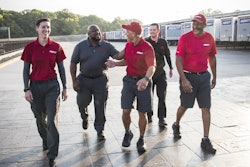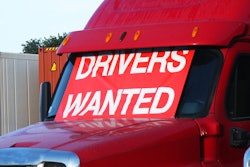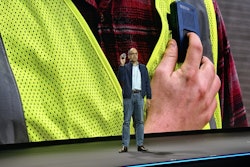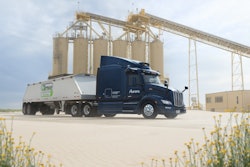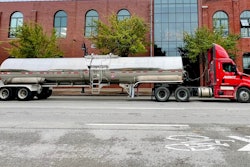In a competitive job market fleets face significant challenges in both acquiring and retaining driving talent. The first 30 days of employment is a crucial period for driver retention and a clunky or inefficient orientation process is the first red flag your company might not be a good fit.
A driver-first, automated onboarding system not only gets drivers on the road faster but also fosters a positive initial experience, which is critical for long-term retention in an industry with high turnover.
Speaker 1:
Driver first, hiring how fleets can win talent with streamlined onboarding. Hey everybody, welcome back. I'm Jason Cannon and my co-host is Matt Cole. Finding good help these days is hard and keeping that good help is tricky, especially in a job market that's as competitive as finding truck drivers.
Speaker 2:
Most drivers decide to stay with or leave a fleet within the first 30 days, and the first thing that most often tips the scale is a clunky orientation.
Speaker 3:
It all comes down to why do they leave in the first 30 days? I think there's probably a number of reasons that they leave. They may not like their manager, they may not like the experience, but one of the things that we found has the biggest impact on somebody's retention is the experience that they have when they come onto your company. If you think about it, that's the first engagement they have. Maybe they have an interview, maybe they meet with somebody in hr, but the first experience that they have with the technology of your company is their onboarding experience. And if it is cumbersome, lackadaisical requires a ton of input, a ton of manual effort. That's how they're going to view your company coming into the organization. And so we've all long viewed that this experience is more critical than just how fast we can get them on. It's also making sure that's a positive experience so that they come on with that positive energy and it serves as a fulcrum to ensure that they stay longer within your company.
Speaker 1:
If your orientation and onboarding processes haven't changed in several years, it's probably time for a tuneup. Sure, some of the things you have to do are required by the DOT or F-M-C-S-A, but the pieces that make up that process can all be streamlined.
Speaker 3:
So look, one thing about driver onboarding is the, the DOT and the F-M-C-S-A have basically outlined all of the protocol of what you legally need to do when you're bringing a driver on board. And I would say the biggest change that there has been over most recent years is the automation of a lot of the requirements that are required to come on as a truck driver. So these are things like your employment verifications, your physical requirements, and then along with that, the construction of your driver qualification file. And for the longest time, these were all separate processes. You'd have a compliance team within your company that was responsible for building your DQ and your verifications for DOT and F-M-C-S-A. You'd have another team in HR there was responsible for finding and sourcing the drivers, doing the interviews, potentially going through the background check. And ultimately, this created a ton of inefficiency because you have two different teams working towards the same goal. And the biggest change most recently is creating this integrated workflow where when you're being onboarded versus you engaging with a compliance team, engaging with an HR team, you're going through one streamlined integrated workflow that takes you from application all the way to sitting in your seat and driving your vehicle.
Speaker 2:
If you're looking to modernize your onboarding process, Kenna says you really should lean into automation and the efficiencies that it creates,
Speaker 3:
It comes down to automation. You want the, especially in the field of driving there is high competition even still, right? Turnover is pretty high. You see that there is driver fallout. Drivers will work for a few months and then find a role with another company. And so it is all about driving efficiency in this process. To your point, they don't want to sit there and go through things that they know just to go through the process. And so it's about combining the aspects of compliance, so everything required by the F-M-C-S-A, the DOT, but putting that into a streamlined automated process so they can do everything from their phone, every application, every set of that process can be done right from their phone until they are ready to work for the organization. Basically, the gist of it is the more integration that you can bring to that process, the more streamlined that experience is going to be for the driver, the faster that they will be able to join your organization.
To us, the process is such that they move from each one of the stages of onboarding, and I'll start at their application through their interview, then they're able to seamlessly move into what we would refer to their background and DOT verification process. And then from there, we want to be able to take all of that information we've collected already and push that into our DQ solution so that there isn't this double, triple, maybe even sometimes quadruple input or interaction with the driver. They are just at the front end providing their information and then seamlessly through the process giving a little bit more. But we're carrying that data along the onboarding process so that for them it's just one seamless workflow. And then from the other side, companies can ultimately just expect that a driver is approved for hire, they're going to seamlessly move through this process, and there is no interaction that they have to have to go get information from the compliance team or reach out to hr. It all just seamlessly moves through the process.
Speaker 1:
Siloing the onboarding process for drivers, Kenneth says, is something that most carriers get wrong most often.
Speaker 3:
I would say that what they get wrong, at least as it relates to the front end of the onboarding process, is taking each step for itself and making each step a unique process. And so we still see today many organizations operating with silos between their compliance team and their HR team. And what we see is they send somebody through the background check, they do all their employment verifications per the DOT, and then they go through an entire additional process with a DOT application with a compliance team. And imagine you are that driver and another organization you've applied once they extend all your information through. And the second call from that company is, Hey, we're ready for you. What day can you start? And the other company is, well, we also need your DOT employment. Do you mind providing that? We need you to go for a physical as well. And so imagine which company is going to win that candidate over when you think about the experience for the driver themself.
Speaker 1:
That's it for this week's 10 44. You can read more on ccj digital.com. While you're there, sign up for our newsletter and stay up to date on the latest in trucking industry news and trends. If you have any questions or feedback, please let us know in the comments below. Don't forget to subscribe and hit the bell for notifications so you can catch us again next week.
